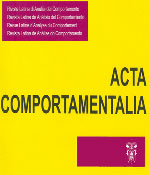Non- differential signaling of various probabilities of water delivery in two subcycles of a temporally defined schedule
DOI:
https://doi.org/10.32870/ac.v8i1.14646Keywords:
temporally defined schedules, stimulus control, stimulus probability, stimulus omission, rats.Abstract
An experiment was conducted to evaluate the effects of correlating one stimulus with either of the two subcycles of a temporally defined schedule (using various probabilities of water delivery). A 60-secs temporal schedule was employed, tD and t5 being 30 secs long. The probability of water delivery in tD varied from 1.0, to 0.75, 0.5, and 1.0 across phases, whereas the probability of water delivery in t varied from 0.0, to 0.25, 0.5 and 0.0 across phases. Each of the three first experimental phases was followed by five non-contingent probe sessions using the same probability values. In one group of rats tD was correlated with a green light, whereas in another group t5 was correlated with a white light. All rats showed an increasing trend in responding across phases, the highest response frequency being observed when both probabilities were equal to 0.5. The rats for which the t5 subcycle was signaled showed a higher response frequency in t5 in t5 than in tD. The percentage of water deliveries decreased across sessions in all rats. The results are discussed in terms of the discriminability of probabilities in each subcycles and of the number of water deliveries obtained in the initial cycles of each session.
Downloads
Downloads
How to Cite
Issue
Section
License

<a rel="license" href="http://creativecommons.org/licenses/by-nc-sa/4.0/"><img alt="Licencia de Creative Commons" style="border-width:0" src="https://i.creativecommons.org/l/by-nc-sa/4.0/88x31.png" /></a><br />Este obra está bajo una <a rel="license" href="http://creativecommons.org/licenses/by-nc-sa/4.0/">licencia de Creative Commons Reconocimiento-NoComercial-CompartirIgual 4.0 Internacional</a>.






